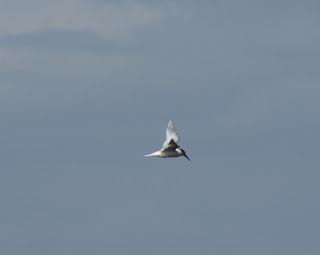 |
| One of many Siskin Lugano Carduelis spinus |
 |
| Red Squirrel Ardilla Roja Sciurus vulgaris enjoying its morning snack of pine seeds |
More Crossbills and then we mad our way down the steps to walk along the lower path. Not only a plentiful supply of Siskins and more Crossbills and Chaffinches but a solitary Mistle Thrush huddled up in a tree before departing and then the first of many Blackcaps. A Robin put in an appearance and, best for me, we all got to admire the newly-arrived Firecrest as it fed in the tree immediately in front of us. Meanwhile we had a Red Squirrel above us enjoying a breakfast of pine seeds and Derek had a magnificent view of a male Hawfinch on the other side of the stream. For the rest of us, we had to make do with the flight across and above us accompanied by the female Hawfinch. In addition, Jerry and a few others heard the distant call of a Tawny Owl from the higher slopes opposite where the bird is known to root. Returning to the cars after our ninety minute visit we had a Coal Tit in the trees above and as we departed more Crag Martin sightings above.
Following a refreshment stop we then made our way to Fuente de Piedra where we found much more water with flooded field and scrapes and even water on the main salina. An immediate stop as we entered the site revealed a good number of Stone Curlew in the filed to our right and handful of Jackdaws behind them near the old electricity tower. The flooded approach field on the left held a handful of Shoveler, female Teal and single Black-winged Stilt at the back. To the right a single Lapwing and Chiffchaffs feeding in the nearby trees. A large flock of Greenfinches flew out and back over the water and then a Blackbird before reaching the car park.
First to the boardwalk where we found more Black-winged Stilts and a Meadow Pipit busily preening following it s early morning ablutions. A couple of Stonechat in front of us and the first Moorhen of the day. At the back towards the main water we had a pair of Kestrel and then a Marsh Harrier gently drifted across in search of a meal. A handful of Linnets moved across the reeds before we started our walk back along the edge of the stream towards the entrance to the laguneta recording Crested Larks on the way.
 |
| Flamingos Flamenco Comun Phoenicopterus roseus and company |
 |
| Mainly Shoveler Cuchara Comun Anas clypeata |
 |
| Preening Spanish Sparrow Gorrion Moruno Passer hispaniolensis |
What a change from ten days ago when we arrived at Laguna Dulce. Lots more water following the recent rains but, although lots of birds still to be seen, numbers had been drastically reduced from our previous visit. Goldfinches and Chiffchaff flitting about the neigbouring trees then to the hide. Most of the bird life was on the far side but we did have nearby Little Grebe and Mallard plus the odd Coot. At least four Marsh Harriers on site and to the far right a small number of Famingo and maybe two score Red-crested Pochard plus a small number of Teal.
 |
| Resting Marsh Harrier Aguilucho Lagunero Circus aeruginosis at Fuente watched by Little Grebe Zampullin Comun Tachybaptus ruficollis on water hoping he's not the next meal! |
A good number of both Mallard and Shoveler at the back along with over an hundred Coot. Derek and Barbara managed to find a distant pair of Great Crested Grebes and we all saw plenty of both Little and, not so many, Back-necked Grebes. Still probably fifty plus White-headed Ducks on the water and to me extreme left I found a quintet of Avocet swimming away from the bank.
 |
| Female Common Kestrel Cernicalo Vulgar Falco tinnunculus |
In the scrub below the hide we had a single Snipe, the occasional Moorhen and a few White Wagtails. The score or so Crane were in the far field towards the ruined farm and I thought I had found a male Hen Harrier but as it started to hover we all realised it was a Black-shouldered Kite; not just one but a pair. I ought also to clarify that in addition to the many Crag Martins feeding over the water, the large number of gulls seemed to be solely Black-headed Gulls. We even had a Hoopoe visit the nieighbouruing hide.
 |
| Hoopoe Abubilla Upupa pops |
Leaving the water to start our journey home via Malaga we made a brief stop at the Penarrubia cliff to record both Griffon Vulture and more Crag Martins along with a soaring Sparrowhawk noticed by Jerry. Derek found a very distant Blue Rock Thrush near the top of the cliff face and there was a good-sized raft of Coot on the lake below. What a way to end a great day's birding in wonderful company and a final list of over 60 species.
 |
| A trio of Stone Curlews Alcaravan Comun Burhinus oedicnemus as we approached Fuente de Piedra reserve |
Gadwall, Mallard, Shoveler, Teal, Red-crested Pochard, Common Pochard, White-headed Duck, Little Grebe, Great Crested Grebe, Black-necked Grebe, Flamingo, Black-shouldered Kite, Red Kite, Marsh Harrier, Griffon Vulture, Sparrowhawk, Kestrel, Moorhen, Coot, Crane, Black-winged Stilt, Avocet, Stone Curlew, Lapwing, Snipe, Black-headed Gull, Lesser Black-backed Gull, Rock Dive, Wood Pigeon, Tawny Owl, Great Spotted Woodpecker, Crested Lark, Thekla Lark, Crag Martin, Meadow Pipit, White Wagtail, Robin, Black Redstart, Stonechat, Blue Rock Thrush, Blackbird, Mistle Thrush, Cetti's Warbler, Sardinian Warbler, Blackcap, Chiffchaff, Firecrest, Coal Tit, Blue Tit, Great Tit, Jackdaw, Raven, Spotless Starling, House Sparrow, Spanish Sparrow, Chaffinch, Serin, Greenfinch, Goldfinch, Siskin, Linnet, Crossbill, Hawfinch.
Check out the accompanying website at http://www.birdingaxarquia.weebly.com for the latest sightings, photographs and additional information






































